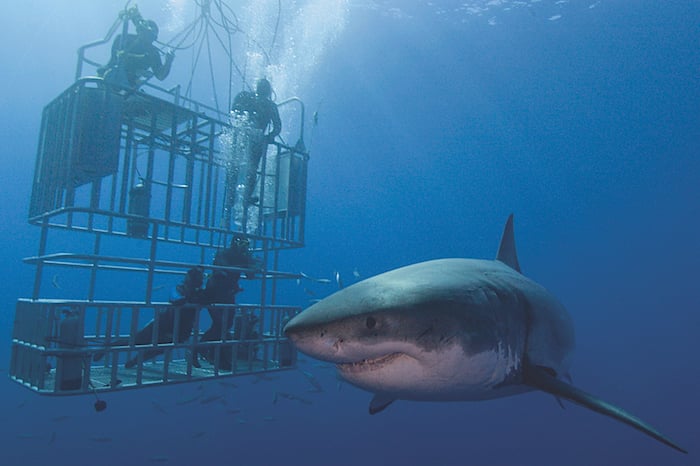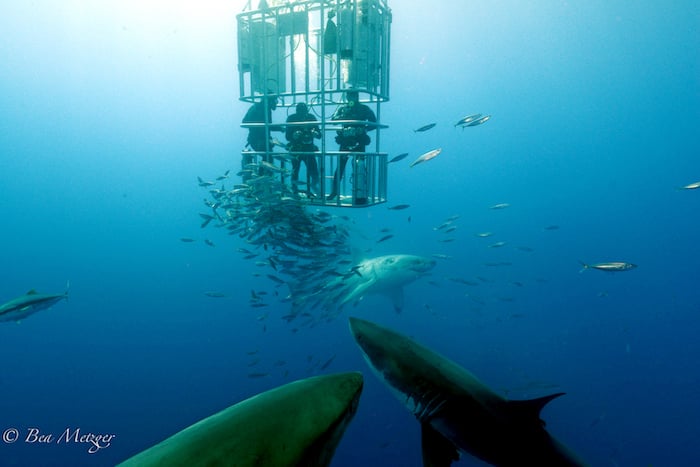Top Tips for Cage Diving with Sharks

Cage diving with sharks is an incredible experience offered at destinations around the globe. One of the premier places for great white shark cage diving is Guadalupe, where divers can experience these sharks in warm, crystal clear water. Guadalupe is known for its large female great white sharks, up to 18 feet length, that congregate at the island each September. Scuba diving experience is not required for cage diving at Guadalupe, making it accessible for all.
Whilst the risk of injury or accident whilst cage diving with sharks is very low, there are some extra considerations divers can take to ensure a comfortable and safe cage dive.
Choose the right exposure suit for cage diving
Cage diving is less active than regular scuba diving and involves being mostly still within a cage, and for an extended time. As such, divers can expect to get colder, and more quickly, than during a regular dive. It is important for divers to consider the water temperature at their chosen destination.
As an example, Guadalupe’s water temperature is 19 to 22 degrees Celsius and is best dived from August to October whilst wearing a 5mm to 7mm wetsuit. By comparison, scuba diving in O’ahu Hawaii is warmer, with water temperatures of 23 to 26 degrees Celsius. Cage diving with Galapagos and sandbar sharks is available from O’ahu.
Choosing the right exposure suit for the destination ensures a comfortable experience and maximum time in the water with the sharks. Divers may also wish to consider using a hood and gloves for extra warmth in the cage.
Take extra clothing for warmth and quick removal when sharks arrive
Taking the right clothing for in-between dives is always important and useful kit additions for cage diving on colder days are a woolly hat and wind-proof jacket. The arrival and departure of sharks near the cage can never be guaranteed, so it is useful to always be ready to get into the cage at short notice. A wind-proof jacket over a wetsuit and a woolly hat can provide warmth whilst waiting for sharks to arrive and they can be quickly removed when it’s time to dive.
Choose the right air source and depth for your experience level
Cage diving can be conducted at the surface or at depth, and so is suitable for divers and non-divers alike. Cage diving operators will provide snorkels, hookah dive systems, or open circuit setups, depending on whether the cage dive is at the surface or at depth. It is important to choose a destination with the right type of equipment and dive style for the diver’s needs and experience level.
For those divers new to shark diving or open-ocean diving, a surface cage dive using a snorkel is a good introduction. It makes experiencing the sharks easier as there is no consideration needed for scuba gear and being at depth. Surface dives are also good for divers who are fearful of sharks, as they can return to the boat easily if they want to.

Follow cage safety procedures to prevent injury
Cage diving is extremely safe and accidents rarely occur. However, getting in and out of the cage must be done carefully and the safest entry technique is a controlled seated entry, with hands and equipment kept away from the gap between the cage and the boat. It is advisable to ask the crew to pass cameras to divers once they are within the cage and vice versa before exiting the water. Divers should stay within the cage whilst in the water and be careful not to trap fingers or equipment between the cage bars and the boat. Divers should be especially mindful when the cage lid is being lowered in choppy conditions and keep their hands away from the rim of the cage.
Take motion sickness precautions for surface cage dives
If a diver is prone to motion sickness, it is worth taking extra motion sickness medication or precautions for surface cage dives. The ocean surface can be choppy and the movement of a cage exaggerates the feeling of motion for divers at the surface.
There is less cage movement to deal with during deep cage dives than at the surface. Cage diving at depth also provides a more immersive experience and can be a good option for those prone to motion sickness.
Eat well to keep warm in the cage and stay hydrated
As with any scuba dive, it is important to hydrate properly and eat adequate food to keep warm in the water. Although divers in the cage move around less, keeping warm will burn calories quickly. Be sure to eat plenty of food when needed and drink water throughout the day. Having small amounts of plain food can also help those divers who are prone to motion sickness in the cage.
Check snorkels are not caught in the cage lid
Snorkels are one of the easiest pieces of dive equipment to use in the water but they are worth considering differently when cage diving. Some operators will use snorkels instead of other types of breathing apparatus for surface dives and they are easy to use. They can, however, get caught in cage lids or bent, causing the snorkel end to dip into the water. Cage divers should regularly check their snorkels have access to the air and not assume they will be free of water because it is a surface dive. Divers who find using a snorkel difficult for that reason can try breath-holding instead and duck under the water to watch when a shark passes by.
Avoid eye contact to encourage cautious sharks to come closer
Great white sharks each have different personalities and some can be cautious about swimming past a cage, particularly if they are being watched. They are ambush predators and usually approach novel objects in their environment whilst trying to remain unseen, to protect themselves from potential harm. With that in mind, avoiding direct eye contact with a cautious shark can encourage it to come closer and pass by until it gains confidence.
Protect camera equipment from accidental damage by sharks
Cameras and other electronic equipment should be kept close to the body and within the cage when diving with sharks unless the boat crew advises otherwise. The small electrical current emitted by a camera as small as a GoPro can be detected by a shark, causing them to potentially investigate further and damage the equipment.
Sharks can also detect the small electric field given off by boat motors, which is why they have occasionally been known to mouth motors to establish what they are.
Observe shark interactions from the top deck
One of the best places to observe shark behavior in-between dives (or if diving is not possible/not desired) is from the top deck of a vessel. Such a wide and often uninterrupted view provides a great opportunity to watch shark interactions whilst learning more about individual sharks from the crew.
Some shark species, including great whites, establish dominance based on size. The largest shark is usually in charge and smaller ones will give way to it. Spending time on the top deck whilst there is shark bait in the water allows divers to witness shark dominance in action. It also provides a chance to get to know the different personalities of sharks and to recognize individuals by their coloration and markings. No two great white sharks are the same and their unique markings and individual personalities are diverse and fascinating.
The following liveaboards offer Cage diving trips to Guadalupe, Mexico;










